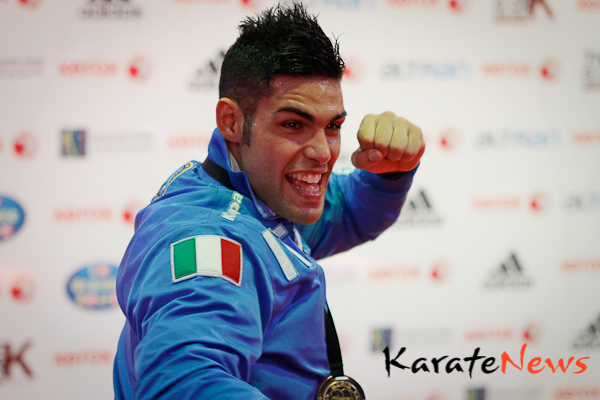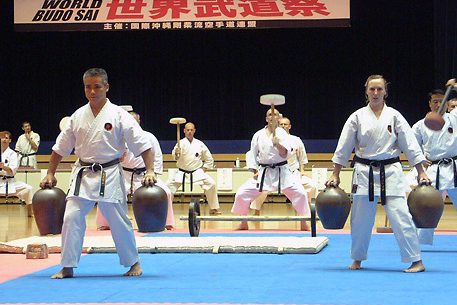Last monday, after class, a sempai came to me and asked me what it was like in ‘ye old days’ if you wanted to train under some legendary master in Okinawa.
“How was the training conducted? How much did it cost? Who could train? Where did they train?”, and so on. Okay, he didn’t ask those exact questions, he just thought I should write something on it.
Just to be clear, we’re talking about the time when Karate had not yet been popularized in mainland Japan, and was being carried out in utmost secrecy under the nose of the government who had instituted the ban on martial arts, weapons etc. some 400 years earlier.
“It would be sweet if you could write some on your site about it!” he told me.

“Well, why not? I guess more people could be interested. I’ll see if I can put something together about how they trained in backyards during the night, did chores for their masters and all that stuff, you know?” I said.
His eyes lit up: “WHAT? Doing chores for their masters? But that must have been terrible! You mean, like clean their house and wash their clothes? That’s just madness!” my friend replied astonished.
Apparently, he had never known about the gruesome underground conditions the oldtimers had to train in.
So I said: “Madness? MADNESS?!?! THIS IS SPAAARTAAAAA!!!! OKINAAAAWAAA!!!!!”
All my conversations go like this.
So, anyway, let’s talk about ‘ye old Karate’, shall we?
If you wanted to learn Karate (or Te/Ti/Toudi as it was then called) during the 1800’s or earlier in Okinawa, chances were slim that you’d actually find a sign that said “Okinawan Karate School – Trial Month for ONLY $30! Includes free uniform and unlimited classes for a month!”
Nope, you’d have to search a little more.
Karate was not something that was ever publically announced or spoken about, so if you wanted to learn Karate you’d better have the right contacts and be in the right end of the word of mouth.
Why?
Why didn’t teachers put out large signs? Didn’t they want more students? How did they cover the rent then?
Well, the old-school teachers didn’t teach for money. They didn’t care if they had 5, 10 or 20 students, as long as the students were made of the right stuff – masters would only accept students of the highest moral character. Money, which was considered something for low-class people, was acquired by other means.
Indeed, the old masters took their martial arts very seriously, and went to great lengths to avoid teaching the deadly arts to the wrong people. In many cases the instructor required the potential student to do chores and other menial labor for weeks or months so that the student’s true character could be seen.
“Pick up that rock. Put it there. Clean my garden. Good. Now clean it again. Get me some water. Get me some sake. Pick up another rock. Stop picking up rocks, you’re ruining the garden! Get me some more sake. Pick up that rock.”
Training would begin only after the instructor was pleased with the student and his character (self-discipline, respect, manners and obediance being top priorities).
The master also made sure that the student understood the value of what was being taught, and that the student understood the training would be rigorous. A strong sense of giri (loyalty, obedience) was forged in this process, something which is very important in the Japanese/Okinawan Confucian society even today (Confucianism provided the ethical basis for many things, like giri, the sempai/kohai/sensei system etc.).
In other words, since you had done these boring chores and duties for such a long time, the chances of you quitting Karate classes was slim to none. Sure, you hadn’t paid any actual money, but you had paid with a far more valuable resource – time and commitment.
The masters knew this, of course.
I mean, if they were to spend time teaching you all kinds of secret stuff, they wanted to make sure you had such a strong bond with them that you would never want to leave! That is what giri is all about.
Loyalty.
But, other payment was made too. As customary, if you wanted to become a pupil of a master you had to not only wash his dirty underwear but also bring him gifts. Sake, meat, fruit, sweets… these were the things a master craved.
For instance, Chibana Choshin, the legendary Shorin-ryu (Kobayashi) Karate pioneer was denied acceptance three times when he first wanted to learn Karate as a kid, from his seemingly evil master Itosu Anko.
Eventually master Itosu accepted him as a student though, and Chibana went on to become on of the most skilled Karate legends in history.
But that was not always the case.
Sometimes it turned out bad.
Real bad.
Around 1908, after completing the traditional apprenticeship period of some ten years, Kanbun Uechi (founder of Uechi-ryu Karate) opened his first own school in Nan-p’ing, Fukien province, China, the place he had travelled to from Okinawa many years earlier to learn the secret art of chuan fa (kung-fu). This was before he founded Uechi-ryu Karate.
Kanbun Uechi’s dojo was very successful and well known, until disaster struck.
In a mysterious land dispute, one of his students accidentally killed a man!

Uechi was shocked. He immediately returned to Okinawa in February of 1910, after having only taught 2 years in Nan-p’ing, and, disillusioned by the incident in China he made a vow.
He decided to never to teach or speak of Karate ever again.
He actually married an Okinawan woman and started farming instead.
Of course Uechi was unable to keep his skills a secret, so later (around 1927) Uechi opened his teachings to the public again on a limited basis after having refused teaching many people for years.
So, you could definitely say that the old masters had reason to choose their students carefully.
Now that we know how the selection process was conducted… what about training?
As Funakoshi Gichin himself writes in ‘Karate-do: My Way of Life’:
At that time the practice of Karate was banned by the government, so sessions had to take place in secret, and pupils were strictly forbidden by their teachers to discuss with anyone the fact that they were learning the art. I shall have more to say on this subject later on; for the moment, suffice it to note that Karate practice could then be held only at night and only in secret.
As you see, if you decided to train Karate you couldn’t even speak of it.
While we’re at it, here’s some more from Funakoshi (yes, I love this book). This is a good part:
I taught school during the day and then, in the dead of night, I made my stealthy way, carrying a dim lantern when there was no moon, to the house of master Azato. When, night after night, I would steal home just before daybreak, the neighbors took to conjecturing among themselves as to where I went and what I was doing.
Some decide that the only possible answer to this curious enigma was a brothel!
The truth of this matter was very different indeed. Night after night, in the backyard of the Azato house as the master looked on, I would practice a kata time and again, week after week, sometimes month after month, until I had mastered it to my teacher’s satisfaction. This constant repetition of a single kata was grueling, often exasperating and on occasion humiliating. More than once I had to lick the dust on the floor of the dojo or in the Azato backyard. But practice was strict, and I was never permitted learning new techniques until I had satisfactorily understood the one I had been working on.
Although considerably advanced in years, he [Azato] always sat ramrod stiff on the balcony when we worked outside, wearing a hakama, with a dim lamp beside him. Quite often, through sheer exhaustion, I found myself unable to make out even the lamp!
After executing a kata, I would await his verbal judgment. It was always terse. If he remained dissatisfied with my technique, he would murmur, “Do it again,” or, “A little more!”
A little more, a little more, so often a little more until the sweat poured and I was ready to drop: it was his way of telling me there was still something to be learned, to be mastered. Then, if he found my progress satisfactory, his verdict would be expressed in a single word “Good!”
That one word was his highest praise, and until I had heard it spoken several times, however, I would never dare ask him to begin teaching a new technique [kata].
So, not only did you have to endure menial chores and humiliating tasks for weeks and months before you started training, you had to endure training the same kata over and over again even after you’d been accepted as a student.
Folks, this was for real.
This was the kind of Karate you didn’t train because you wanted a “fun pastime activity”. When you had sacrificed so much to be a part of this movement, it was more than a hobby.
It was a calling.
Or, perhaps it wasn’t, but it must surely have felt so.
And the results were of course great.
This long a grueling process produced some of the most notable masters we know of in history. Would pioneers like Funakoshi, Miyagi and Chibana have continued practising if they could just have bought a “Special offer $59 4-week Karate introduction pack”? Would they have felt the same sense of loyalty, discipline, duty and respect for hard work?
No.
Definitely not.
They would say, “Screw this old man, I’m going out drinking sake with my mates!” instead.
Because money come and go.
Since these dudes had instead paid with time, sweat, tears, blood and feelings (guilt, loyalty respect…) they had invested far more than they perhaps knew in this thing called Karate, and the notion of this was probably what helped them through the first hard years of training before they became accustomed to it.
Becoming great under these conditions wasn’t a possibility, it was a probability.
But, like everything else, this “apprentice system” had a big, biiiig, major flaw.
You couldn’t ask questions.
Well, you *COULD*, I mean, nobody sewed your lips together or anything, but at the same time you couldn’t really.
If a master had finally decided to accept you, after a long and hard process… you’d best to shut up and train or you would be kicked out before you had even tied your underwear on (training was done in undergarments by the way). To even dare ask your master a ‘stupid’ question, after all he had done for you (sic), was a severe breach of protocol, and you’d better keep quiet and always do as told.
If the master wanted to tell you something, he would say it.
That was the Confucian way.
You would never bother your master.
And this, as we know, isn’t good. This is the exact reason to why we have quotes like these hanging around from back in the days:
“Studying karate nowadays is like walking in the dark without a lantern. We have to grope our way in the dark.” said Miyagi Sensei. He also told me, “There are so many things in karate which does not make sense and there are a lot of things I cannot understand.”
– Genkai Nakaima, ‘Memories of My Sensei, Chojun Miyagi’, 1978.
As you see, Chojun Miyagi himself admitted quite frankly to not knowing what the frick he was really dealing with.
“Karate?”
Bear in mind, Miyagi was one of the biggest Karate authorities in those times, a man who founded one of the world’s most popular styles of Karate today (Goju-ryu). This is an important and serious statement.
But he was not alone.
For instance, Shiroma Shinpan (Shito-Ryu):
“…often admitted to not knowing the technical functions of certain movements and hand forms in the Katas and would quite blankly state that Itosu sensei [the legendary ‘father of modern karate’] had not known the functions either, merely explaining that they were for ‘show’.”
– Bishop, ‘Okinawan Karate’, 1989.
Miyagi Chojun didn’t know.
Shinpan Shiroma had no idea.
Itosu Anko (omg!) had no clue.
Because they were never “allowed” to ask their teachers.
If they had, that would have been their last question. And they sure as hell didn’t want to ruin this great relationship they had built; by carrying water and cleaning the masters toilet for months and years (yes, chores continued even after you’d been accepted as a student).
Since it’s time to finish this post in a minute (I’ve covered basically everything I intended to) which way is the “best” then?
The way we teach today, or the way they taught back then?
Old-school, or new-school?
Well, I think both approaches were (are) greatly influenced by the outer social circumstances from which they have evolved, and thus have evolved that way for a reason. Changing things for no reason makes no reason. Get my reasoning? Is it reasonable?
Of course, that is not to say things can’t improve.
The best approach, in my view, would probably be to combine some of the physical characteristics (repetition until perfection, more emphasis on basic techniques, strenghtening tools, makiwara etc) and psychological characteristics (a serious no-nonsense approach to learning and training etc) of old-school Karate with our modern understanding of teaching models (feedback steps, questioning, reflection and introspection etc) and educational systems (make money, money, make money, money, moneeey!) along with a tad bit more scientifically proved training than before (5000 situps!).
That approach would be a true win-win, and would produce some mighty fine Karate men.
So why don’t we see this everywhere?
Hmm…?
Aah… I forgot.
“The less there is to justify a tradition, the harder it is to get rid of it”.
– Mark Twain
Tradition.



11 Comments